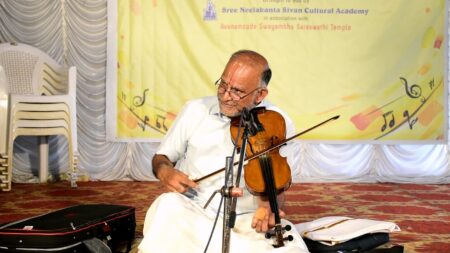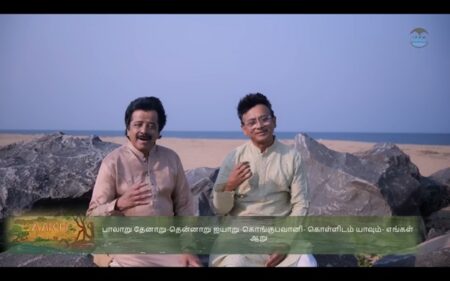Lata Mangeshkar mostly sang light music, but her singing was deeply rooted in Indian classical music.
Indian classical music is often thought of as a path to salvation. Lata Mangeshkar was one of those rare artists, who, in spite of her career in light music, could show everyone the path to salvation, in an effortless manner. She was an ambassador of every genre of music that can be Indian classical music. Her repertoire includes Khayal, Bhajans, Ghazals, and other semi-classical songs of different Ragas. The great Bala Gandharva popularised many Ragas through his Natya Geets; Lataji did the same through her film songs.
Swayambhu Gandhar
Before diving into Lata’s Sadhana, let me explain the term Swayambhu Gandhar. There are many microtones that can be listened to on the 4th string (which is tuned to the lower sa) of the Tanpura. One of these is Gandhar, which can be listened to without actually tuning the string to that note.
An artist who has that kind of voice is said to possess Swayambhu Gandhar (a symbol of the Anahat Nada, which is in the realm of the abstract]. Artists like Bhimsen Joshi and Jasraj had to do painstaking Sadhana to get this flavour in their voice, but Lata had got it naturally. People attribute her success to this cosmic voice, but in my opinion, the secret of her success lay in the way she had cultivated this god-given gift.
The great Marathi Bhavageet singer Arun Date says, “I have listened to many classical maestros. They used to sing as if they were the ruler of a particular note, but Lata Mangeshkar was the only artist who effectively ruled all the seven notes.”
Ustad Bismillah Khan once said: “I’ve heard Lata all my life, and I wanted to see her go out of tune at least for once But this has never happened.” Ustad Bade Gulam Ali Khan thought the same way, too. According to singer Suresh Wadkar, “The secret of Lata’s success is in her effective timing. She would sing each phrase at the right speed. Her Marathi song Ye Javali ghe Javaliis a good example of this timing.”
Natural firat
Lata’s father Dinanath Mangeshkar was her first guru, and she had mastered many raags at a tender age. At the age of 9, she sang a khayal in raag Khambavati. In his last days, Dinanath told Lata that the tanpura was a Sadhu Purusha, and if she served it well, she could achieve anything she desired in life. Lata followed her father’s advice to the hilt, and the rest is history.
Dinanath was well known for his natural firat, and Lata inherited it. Listen to songs such as Aap ki nazron samjha (raag Adana), Manmohana bade jhoothe, Mohe panghat pe Nandlal ched gayo re (both raag Jaijaiwanti), you will realise her mastery of ultra-fast tans.
Shrinivas Khale, a great Marathi composer, was well known for effectively using very complex laya patterns in his tunes. When Lata sang songs such as Shravanat ghana nila barasla or Nija majhya nandalal, for Khale, she showed her effective handling of laya without disturbing the emotive appeal of the composition.
Lata has sung very complex songs such as Kuhu kuhu bole koyaliya (raag Mala), or Marathi songs such as Ya chimanyano (raag Din ki Puriya and Marwa), or Savar re, savar re (which uses three talas — Jhaptal, Keherwa, and Dadra — along with many non-regular swara patterns). They looked simple to the common man because of her artistic excellence.
When one sings light music, it is necessary that one’s musical excellence should not overshadow the content of the lyrics. It should rather remain unseen, like the soul of an individual. Even when Lata sang these complex songs, she did not overshadow the words with any musical gimmicks. It came from her heart, and she never tried to show off.
Expressions of Lata Mangeshkar
Lata Mangeshkar has sung for scores of actors. She has sung in almost all Indian languages as well as many foreign languages. She always paid great attention to the correct pronunciation of the words in the lyrics. She would observe the actor’s expressions and style of speaking. She was also mindful of the character singing the song. Listen to the song Hai isi mein pyar ki abru, and you will notice her expressions for the words main shamma ban ke jala karun, or Na bahar aaye to kya karun.
The song Jiya le gayo ji mora savariya is another example. In this song, the various ways in which she has expressed the first line shows the different emotions of the girl who has fallen in love.
The song Lag ja gale can best summarise her effective use of dynamics. The song Zarasi aahat hoti hai is noticeable for her singing of the word who refers to her lover in different ways. It is well known that she never ate non-vegetarian food while recording devotional songs. Her purity of heart and her strong faith get reflected in her abhangs, such as Sundar te dhyan. Her Meera bhajans beautifully reflect Mirabai’s love and longing for the ultimate meeting with God.
Lata Mangeshkar’s mastery of music and her command of expressions made her a true ambassador of Indian classical music. She is one of the global cultural icons produced by India to be cherished by the world forever.




